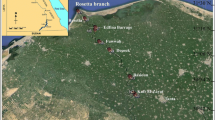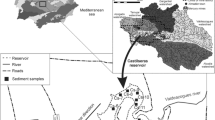Abstract
Concentrations of elements (As, Co, Cu, Ni, Mo, Pb, V, and Zn) are studied in the sediments of two adjacent stretches of Chenar Rahdar river. The first stretch (S1) is influenced by urban and arable land wastewater, and the second (S2) is mainly loaded with industrial effluents. The average abundance order of heavy metals content in S1 sediments is Ni > V > Zn > Cu > Co > As > Pb > Mo and in S2 sediments is Ni > Zn > V > Cu > Mo > Pb > Co > As. The maximum average concentration for these heavy metals (except for As) occurs in the S2 sediments. The contamination factor (CF) base of background in S1 for eight analyzed elements is moderate. The CF for Cu, Zn, and Pb in S2 sediments is considerable. The highest CF in S1 and S2 sediments is observed for Mo (CF = 10.95 and 12.41) and indicates very high contamination. The application of modified degree of contamination values (mCd) indicates low and high degree of contamination (1.89–4.15) in S1 and S2, respectively. Calculated enrichment factors (EF) reveal enrichment of Mo and As in S1 and Zn, Cu, Mo, and Pb in S2 compared to the average abundances of background level. The maximum EF for Mo is 7.61 (significant enrichment), while Pb, Zn, and Cu with maximum EF between 2 and 5 indicate moderate contamination. Principal component analysis (PCA) shows distinctly different elemental associations in S1 and S2 sediments. The strong association of Zn, Co, Ni, Sc, Cu, Al and Fe in S1 suggests a similar source. The results of PCA for Zn, Pb, Mo and Cu in S2 (componente2) indicate that these metals are influenced by anthropogenic activity. Also, high loading heavy metals with OC (0.97) indicate that organic carbon plays a significant role in the distribution and sorption of these heavy metals in the sediments. Factor analysis indicates that As and Mo behave differently in sediment samples.
Similar content being viewed by others
References
Abrahim, G. M. S. (2005). Holocene sediments of Tamaki Estuary. Characterisation and impact of recent human activity on an urban Estuary in Auckland, New Zealand. PhD thesis, University of Auckland, Auckland, New Zealand.
Abrahim, G. M. S., & Parker, R. J. (2008). Assessment of heavy metal enrichment factors and the degree of contamination in marine sediments from Tamaki Estuary, Auckland, New Zealand. Environmental Monitoring and Assessment, 136, 227-238.
Bergamaschi, L., Rizzio, E., Valcuvia, M. G., Verza, G., Profumo, A., & Gallorini, M. (2002). Determination of trace elements and evaluation of their enrichment factors in Himalayan lichens. Environmental Pollution, 120(1), 137–144.
Cook, J. A., Andrew, S. M., & Jonson, M. S. (1990). Lead, zinc, cadmium and fluoride in small mammals from contaminated grass-land established on fluorspar tailings. Water, Air and Soil Pollution, 51, 43–54.
Deniseger, J., Erickson, J., Austin, A., Roch, M., & Clark, M. J. R. (1990). The effect of decreasing heavy metal concentration on the biota of Buttle lake. Water Research, 24, 403–413.
Dı’az, R. V., Aldape, J., & Flores, M. (2002). Identification of airborne particulate sources, of samples collected in Ticoma’n, Mexico, using PIXE and multivariate analysis. Nuclear Instruments & Methods in Physics Research. Section B, Beam Interactions with Materials and Atoms, 189, 249–253.
Dickinson, W. W., Dunbar, G. B., & Mcleod, H. (1996). Heavy metal history from cores in Wellington Harbour, New Zealand. Environmental Geology, 27, 59–69.
Forstner, U. (1985). Chemical forms and reactivities of metals in sediments. In: R. Leschber, R. D. Davis, P. L’Hermite (Eds.), Chemical methods for assessing bioavailable metals in sludge and soils (pp. 1–30). London: Elsevier.
Forstner, W., & Muller, G. (1975). Factors controlling the distribution of manor and trace elements (Heavy metals V, Li, Sr) in recent lacustrine sediments. Resumes des publications IX Congress Intl. De Sedimentologie, Nice, Theme II, P.6.
Gaudette, H. E., Flight, W. R., Toner, L., & Folger, D. W. (1974). An inexpensive titration method for the determination of organic carbon in recent sediments. Journal of Sedimentary Petrology, 44, 249–253.
Hakanson, L. (1980). Ecological risk index for aquatic pollution control, a sedimentological approach. Water Research, 14, 975–1001.
Hernandez, L., Probst, A., Probst, J. L., & Ulrich, E. (2003). Heavy metal distribution in some French forest soil, evidence for atmospheric contamination. The Science of the Total Environment, 312, 195–219.
Hornung, H., Karm, M. D., & Cohen, Y. (1989). Trace metal distribution on sediments and benthic fauna of Haifa Bay, Israel. Estuarine, Coastal and Shelf Science, 29, 43–56.
Jain, C. K. (2001). Adsorption of zinc onto bed sediments of the river Ganga: Adsorption models and kinetics. Hydrological Sciences Journal, 46(3), 419–433.
Jain, C. K., & Ali, I. (2000). Adsorption of cadmium on riverine sediments: Quantitative treatment of the large particles. Hydrological Processes, 14, 261–270.
Jain, C. K., & Sharma, M. K. (2002). Adsorption of cadmium on bed sediments of river Hindon: Adsorption models and kinetics. Water, Air and Soil Pollution, 137, 1–19.
Jain, C. K., Singhal, D. C., & Sharma, M. K. (2004). Adsorption of zinc on bed sediment of River Hindon: Absorption models and kinetics. Journal of Hazardous Materials, B114, 231–239.
Jain, C. K., Singhal, D. C., & Sharma, M. K. (2005). Metal pollution assessment of sediment and water in the river Hindon, India. Environmental Monitoring and Assesment, 105(1–3), 193–207.
Kabata-Pendias, A., & Mukherjee, A. B. (2007). Trace elements from soil to human. Berlin Heidelberg: Springer.
Kaiser, H. F. (1960). The application of electronic computers to factor analysis. Educational and psychological measurement, 20, 141–151.
Klavins, M., Briede, A., Rodinov, V., Kokorite, I., Parele, E., & Klavina, I. (2000). Heavy metals in river of Lativa. Science of the Total Environment, 262, 175–183.
Krzanowski, W. J. (1988). Principles of multivariate analysis. Oxford: Clarendon.
Lee, C. L., Fang, M. D., & Hsieh, M. T. (1998). Characterization and distributing of metals in surficial sediments in southwestern Taiwan. Marine Pollution Bulletin, 36(6), 464–471.
Liu, W. H., Zhao, J. Z., Ouyang, Z. Y., Solderland, L., & Liu, G. H. (2005). Impacts of sewage irrigation on heavy metal distribution and contamination in Beijing, China. Environmental International, 32, 805–812.
Loska, K., & Wiechuya, D. (2003). Application of principle component analysis for the estimation of source of heavy metal contamination in surface sediments from the Rybnik Reservoir. Chemosphere, 51, 723–733.
Miranda, J., Andrade, E., Lo’pez-sua’rez, A., Ledesma, T. R., Cahill, A., & Wakabayashi, P. H. (1996). A receptor model for atmospheric aerosols from a southwestern site in Mexico City. Atmospheric Environment, 30(20), 3471–3479.
Mishra, V. K., Kim, K. H., Kang, C. H., & Choi, K. C. (2004). Wintertime sources and distribution of airborne lead in Korea. Atmospheric Environment, 38(17), 2653–2664.
Moore, J. W., & Ramamoorthy, S. (1984). Heavy metals in natural waters: Applied monitoring and impact assessment. New York: Springer.
Reimann, C., & de Caritat, P. (2002). Intrinsic flaws of element enrichment factors (Efs) in environmental geochemistry. Environmental Science & Technology, 34, 5084–5091.
Salomons, W., & Förstner, U. (1984). Metals in the hydrocycle. Berlin: Springer.
Singh, P. K., Mohan, D., Singh, K. V., & Malik, A. (2005). Studies on distribution and fraction of heavy metals in Gomti river sediments—A tributary of the Ganges, India. Journal of hydrology, 312(1–4), 14–27.
Sutherland, R. A. (2000). Bed sediment-associated trace metals in an urban stream, Oahu, Hawaii. Environmental Geology, 39, 611–627.
Turekian, K. K., & Wedepohl, D. H. (1961). Distribution of the elements in some major units of the earth’s crust. Bulletin Geological Society of America, 72, 175–192.
Yu, K. Y., Tasi, L. J., Chen, S. H., & Ho, S. T. (2001). Chemical binding of heavy metals in anoxic river sediments. Water Research, 35(7), 4086–4094.
Author information
Authors and Affiliations
Corresponding author
Rights and permissions
About this article
Cite this article
Shakeri, A., Moore, F. The impact of an industrial complex on freshly deposited sediments, Chener Rahdar river case study, Shiraz, Iran. Environ Monit Assess 169, 321–334 (2010). https://doi.org/10.1007/s10661-009-1173-5
Received:
Accepted:
Published:
Issue Date:
DOI: https://doi.org/10.1007/s10661-009-1173-5




